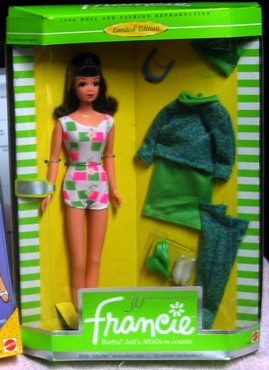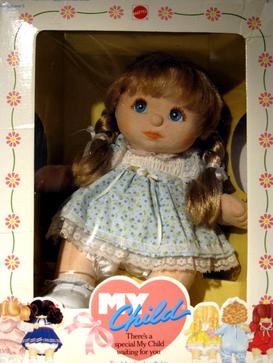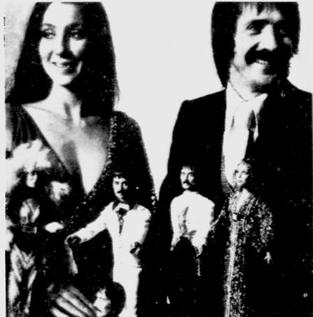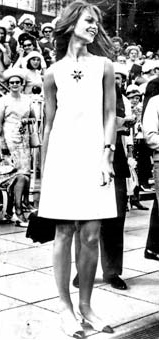This article needs additional citations for verification .(June 2010) |
Daisy was a 1970s doll designed by British fashion designer Mary Quant. [1]
This article needs additional citations for verification .(June 2010) |
Daisy was a 1970s doll designed by British fashion designer Mary Quant. [1]

Daisy was released in the UK in 1973, with the tag line "Mary Quant makes Daisy the best dressed doll in the world". Her name was a reference to Mary Quant's logo, a daisy flower. The doll was manufactured in the 1970s in Hong Kong by Model Toys Ltd, in connection with Flair Toys Ltd. Flair Toys Ltd went out of business in 1980, but Daisy continued to be manufactured until 1983.
The doll is 23 centimetres (9 inches) tall and there are three different versions of her: "Dizzy Daisy", who has a stiff body and unbendable legs, with just her arms and legs swinging up and down from the hips and shoulders; a basic bodied version with bendable legs, as well as the swivelling arms and leg joints; and an active version called "Dashing Daisy", whose body is the most bendable. Her hair colour has ranged from different shades of blond to brunette and red.
Other dolls were manufactured from the same moulds: "Havoc, Super Agent" was released in 1976; and Daisy's best friend, "Amy", who was only available by redeeming daisy tokens from Daisy packages.
Daisy's clothes were designed by Mary Quant and there are hundreds of different models. The doll and its accessories were sold in ordinary local shops. The clothes were cutting-edge 1970s design, as would be expected of Mary Quant, one of Britains leading fashion designers and inventor of the mini skirt and hot pants. Materials included satin, for long evening gowns and flared pants, stretch jersey nylon/polyester for T-shirts, fake "fun fur" for jackets and matching hats, and denim for jeans, waistcoats, hats, skirts and even a boiler suit (very fashionable at the time). Cotton was used extensively for all manner of outfits, long gypsy style dresses, again highly fashionable, blouses, tabards, mini dresses, etc. Patterns were also cutting-edge fashion, including flowers, stripes and polka dots. Footwear included platform clogs and sandals in every colour, and go-go boots with the Quant daisy on the side.
Daisy had her own house, a fold-up country cottage with one room divided by a split level floor for the bedroom area, and a sloped roof, printed inside with windows and wallpaper and outside with stone walls, windows and greenery. Furniture included round 1970s-style kitchen table and chairs, white with pedestal bases which were based on the Eero Saarinen "Tulip" chairs and table, it had a complete set of crockery and cutlery, plus a bowl of flowers, napkins and two paper table cloths. Daisy also had a kitchen sink with orange doors a 'tiled' white back splash and hot water boiler, a stove, again white with orange bottom drawer and set of pans. In the bedroom there is a 'Victorian' range of furniture: a bed made of brass look plastic with two sheets, a pillow and eiderdown in white nylon with pink roses all over, a dressing table with swivel mirror and working (battery) oil lamp, and a wardrobe. These items were originally in brown plastic to represent wood, and then went on to be manufactured in a rich green, the doors of the wardrobe papered in a tiny flower print. The range also included a light pink chaise longue, a cheval dressing mirror and bentwood-style coat and hat stand, a Chesterfield-style arm chair with pedestal side table and an oil lamp.
Daisy also had her own bike with a saddle bag, and a "Daisy mobile", rather like the "Mystery Machine" in Scooby-Doo . Later on she had a scooter which ran on battery power.
Daisy's pets were a dog called Spot, a Dalmatian, a black Labrador retriever and a horse called Archie, which can be found in three colours: white with black spots, brown and a palomino.
Every year a new fashion booklet was issued, showing any new Daisy dolls, and all her latest fashions for that year. Each booklet had a theme; the first, in 1973, being called My Fashion Diary, telling all about Daisy's year and the various outfits she wears each month for various occasions. The 1974 booklet is called My Round the World Holiday, in which Daisy travels the world, showing off more wonderful outfits designed by Mary Quant. Later issues included: My Exciting Life as a Reporter (1975); I'm Having Fun as a Travel Courier (1976); All about my Gift shop (1976); and My Glamorous Life as a Ballerina (1977).
Each fashion book took the reader on a journey in Daisy's busy life. Children could emulate her activities with their own Daisy doll and outfits.
Later fashions (after these booklets) were named "The Optimum" and "Flair" ranges.
Daisy was imitated by other manufacturers, using similar head moulds to make clone fashion dolls. These dolls may be unmarked, or be marked simply "Hong Kong".
Sets of Daisy paper dolls were produced in the 1970s including:
A book, Mary Quant's Daisy Chain of Things to Make and Do ( ISBN 0001033514) was published by Collins in 1975.

Dame Barbara Mary Quant was a British fashion designer and icon. She became an instrumental figure in the 1960s London-based Mod and youth fashion movements, and played a prominent role in London's Swinging Sixties culture. She was one of the designers who took credit for the miniskirt and hotpants. Ernestine Carter wrote: "It is given to a fortunate few to be born at the right time, in the right place, with the right talents. In recent fashion there are three: Chanel, Dior, and Mary Quant."
Popples is a toy and television franchise created by Those Characters From Cleveland (TCFC), a subsidiary of American Greetings. Popples resemble brightly colored marsupial teddy bears with long tails ending in a pom-pom. Each Popple character transforms to resemble a brightly colored ball. In 2018, Popples was sold to Hasbro.
Totally Hair Barbie is a fashion doll, in the Barbie line by Mattel, that was released in 1992. The doll's extra-long hair reached all the way to her toes and at the time, she had the longest hair ever for a Barbie doll at 11.5 inches in length. She is notable for being the highest selling Barbie doll in history, having racked up $100 million worldwide in 1992.
Dawn dolls are small fashion dolls that were made by Deluxe Reading between 1970 and 1973. They measure 6.5 inches in height and have painted eyes and lips. The girl dolls feature rooted hair and eyelashes. The boy dolls have molded hair.

Fashion in the 1990s was defined by a return to minimalist fashion, in contrast to the more elaborate and flashy trends of the 1980s. One notable shift was the mainstream adoption of tattoos, body piercings aside from ear piercing and, to a much lesser extent, other forms of body modification such as branding.

Fashion dolls are dolls primarily designed to be dressed to reflect fashion trends. They are manufactured both as toys for children to play with and as collectibles for adults. The dolls are usually modeled after teen girls or adult women, though child, male, and even some non-human variants exist. Contemporary fashion dolls are typically made of vinyl or another plastic.

What's Her Face! was a line of customizable dolls that straddled the line between traditional fashion dolls and creative activity toys. Made by Mattel, the line ran from 2001–2003, and enjoyed only a modest success in a market dominated by Mattel's iconic Barbie and MGA Entertainment's Bratz dolls. Following the discontinuation of the What's Her Face! line, their body molds were used for the Wee 3 Friends line of Barbie-related dolls. Several fashion, wig, and activity packs were also released for the What's Her Face line.

The National Museum of Costume was located at Shambellie House, in New Abbey, Dumfries and Galloway, Scotland and it formed part of the National Museums of Scotland. The museum started operating in 1982. The museum allowed a look at fashion and the lifestyle of the wealthy from the 1850s to the 1950s. The clothes were presented in lifelike room settings. In January 2013, National Museums Scotland announced that the National Museum of Costume was to close and the site would not reopen for 2013.
Charmin' Chatty was a doll produced by the toy company Mattel in 1963 and 1964. The doll, introduced at the American Toy Fair in New York City in March 1963, belonged to a line of highly successful talking dolls introduced in 1960. Other chatty dolls in the line were Chatty Baby (1962), Tiny Chatty Baby (1963), Tiny Chatty Brother (1963) and Singin' Chatty (1965). Mattel trademarked the word chatty in the 1960s, and some of the packaging for its talking toys carried the tag line, "A Chatty doll by Mattel" or "A Chatty toy by Mattel". Mattel dolls such as Drowsy, Baby Cheryl, and Tatters had the tag line on their boxes that said, "A Chatty Doll by Mattel."

Fashion of the 1960s featured a number of diverse trends, as part of a decade that broke many fashion traditions, adopted new cultures, and launched a new age of social movements. Around the middle of the decade, fashions arising from small pockets of young people in a few urban centers received large amounts of media publicity, and began to heavily influence both the haute couture of elite designers and the mass-market manufacturers. Examples include the mini skirt, culottes, go-go boots, and more experimental fashions, less often seen on the street, such as curved PVC dresses and other PVC clothes.

The Bild Lilli doll was a West German line of fashion doll launched by Greiner & Hausser GmbH on August 12, 1955 and produced until 1964. Its design was based on the comic-strip character Lilli, created by Reinhard Beuthien for the tabloid newspaper Bild. The doll was made of polystyrene, came in two sizes, and had an available wardrobe of 1950s fashion. The Lilli doll was copied, and altered to some degree, for Mattel upon the direction of that company's co-founder, Ruth Handler. Mattel acquired the rights to Bild Lilli in 1964, and production of the German doll ceased in favor of Mattel's new vinyl doll, which they called Barbie.

Sindy is a British fashion doll created by Pedigree Dolls & Toys in 1963. A rival to Barbie, Sindy's look and range of fashions and accessories made her the best-selling toy in the United Kingdom in 1968 and 1970. After Marx Toys' unsuccessful attempt to introduce Sindy in the United States in the late 1970s, Hasbro bought the rights to Sindy and remodelled the doll to look more American. As a result, the doll's popularity declined; in addition, Barbie manufacturer Mattel filed a lawsuit for copyright infringement, which was settled when Hasbro agreed to remodel Sindy's face. During the 1990s, Barbie's share of the doll market continued to grow while Sindy's diminished, which led to Sindy being delisted from major retailers in 1997. Hasbro returned the doll's licence to Pedigree, and the doll was relaunched in 1999, manufactured by Vivid Imaginations. Sindy's 40th anniversary in 2003 saw a new manufacturer, New Moons, and another relaunch and redesign. There were further relaunches in 2016 by Tesco and in 2021 by Kid Kreations. There is a 60th anniversary Sindy doll which was launched at the end of 2023 to celebrate 60 years of Sindy.

Francie Fairchild is a fashion doll issued by Mattel from 1966 to 1976 and re-introduced in 2011. Marketed as "Barbie's MODern cousin" from England, the doll had an extensive line of "mod"-style clothing, often employing bright colors and geometric patterns similar to fashions associated with Carnaby Street in the late 1960s to early 1970s. At 11¼ inches tall, the Francie doll was shorter than Barbie, but taller than Skipper, making the character presumably between the two in age.

My Child dolls are a toy made by Mattel from 1985-1988. Most had felt "skin" on their heads although some had vinyl skin.
Tressy was an American fashion doll with a feature to adjust the length of its hair. Tressy was first produced by American Character Doll Company in the 1960s and later by Ideal Toy Company in the 1970s. The doll was invented and patented by modern furniture designer Jesse Dean and his wife, Diana.

The Sonny & Cher dolls were a collection of 12-¼ inch high celebrity doll likenesses of pop rock duo Sonny & Cher. The line was released by Mego Corporation in 1976. The release of these fashion dolls coincided with the popularity of The Sonny & Cher Show prime time variety TV show.

A Dolly Varden, in this sense, is a woman's outfit fashionable from about 1869 to 1875 in Britain and the United States. It is named after a character in Charles Dickens, and the items of clothing referred to are usually a hat or dress.
Star Fairies was a doll toy series of the 1980s made by the Tonka company. The dolls had different costumes and personalities. Star Fairies was adapted into a televised special, made by Hanna-Barbera in 1985. Family Home Entertainment released the special on VHS in 1986.

On 1965 Derby Day at Flemington Racecourse in Melbourne, Australia, English model Jean Shrimpton wore a white minidress that sparked controversy and was later described as a pivotal moment in women's fashion. The dress was made by Shrimpton's dressmaker, Colin Rolfe, and its hem was 4 in (10 cm) above the knee because he had not been supplied with enough fabric to complete their intended design.

Alligator Rainwear was a British company, whose main factory was based in Stockport. It was best known for its 1960s collaborations with Mary Quant in the design and production of her "Wet Look" collection of PVC raincoats.